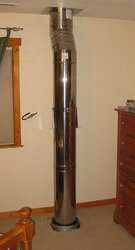Hello all,
We have put in a new delta2 fireplace downstairs. The master bedroom is above this area, which necessitated putting the pipe through the bedroom (see picture).
Last night I built my first (small) fire in the fireplace to try it out, and the (triple walled) chimney got quite warm: warm enough that I could touch it but not hold my hand on it for any length of time.
Apparently code requires we sheet rock 3 walls around this chimney in our bedroom.
I am wondering about (1) installing a vent at the bottom of the chimney with another one at the top, thus to allow convection to heat the bedroom from chimney heat, or (2) to somehow install an in-wall fan at the bottom to blow air in and then force it out the top, or (3) is there another idea I'm missing? Are ideas 1 and 2 up to code?
Thanks in advance for any help,
Sam
We have put in a new delta2 fireplace downstairs. The master bedroom is above this area, which necessitated putting the pipe through the bedroom (see picture).
Last night I built my first (small) fire in the fireplace to try it out, and the (triple walled) chimney got quite warm: warm enough that I could touch it but not hold my hand on it for any length of time.
Apparently code requires we sheet rock 3 walls around this chimney in our bedroom.
I am wondering about (1) installing a vent at the bottom of the chimney with another one at the top, thus to allow convection to heat the bedroom from chimney heat, or (2) to somehow install an in-wall fan at the bottom to blow air in and then force it out the top, or (3) is there another idea I'm missing? Are ideas 1 and 2 up to code?
Thanks in advance for any help,
Sam




 )
)